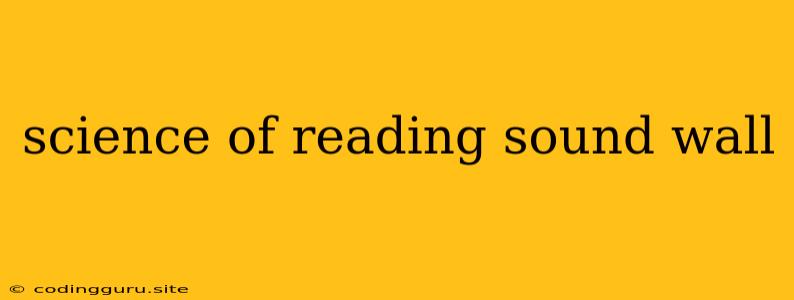Decoding the Secrets of Reading: The Science of Reading and the Sound Wall
The journey to becoming a fluent reader is often paved with challenges, especially for young learners. But what if there was a tool, a visual roadmap, that could help children unlock the mysteries of the written word and develop a love for reading? This is where the science of reading and the sound wall come together, forming a powerful duo in early literacy development.
What is the Science of Reading?
The science of reading is not a new invention, but a growing body of research that provides evidence-based insights into how children learn to read. It emphasizes the crucial role of phonemic awareness, phonics, fluency, vocabulary, and comprehension in the reading process.
But what exactly is phonemic awareness? It's the ability to recognize and manipulate the individual sounds within a word, a skill that's considered the foundation for successful reading. Imagine a child learning to break down the word "cat" into its individual sounds: /k/ /a/ /t/. This understanding of sounds and their relationship to letters is essential for decoding unfamiliar words.
Introducing the Sound Wall: A Visual Aid for Reading Success
The sound wall is a visual tool designed to support students in developing their phonemic awareness and phonics skills. It's typically a large display, often made of chart paper or a whiteboard, where individual sounds (phonemes) are represented by colorful picture cards or sound-letter tiles.
How does it work? Each card or tile represents a specific sound and often includes a picture that helps students visualize the sound. For instance, a picture of a cat might be used to represent the /k/ sound. By organizing these cards into categories (such as vowels, consonants, blends, and digraphs), the sound wall creates a visual map of the English language.
Benefits of Using a Sound Wall in the Classroom
The sound wall provides numerous benefits for both teachers and students:
- Visual support: It's a visual reminder of sounds and their corresponding letters, aiding students who learn best through visual cues.
- Active engagement: It encourages students to actively participate in the decoding process, making learning more interactive.
- Improved phonemic awareness: The sound wall helps students identify and manipulate individual sounds within words, improving their understanding of spoken language.
- Enhanced phonics skills: By visualising the relationships between sounds and letters, the sound wall supports students in developing their ability to decode words.
- Increased confidence: As students become more comfortable with using the sound wall, their confidence in their reading skills grows.
How to Use the Sound Wall Effectively
Here are some practical tips for incorporating a sound wall into your teaching:
- Introduce the sounds gradually: Start with a few key sounds and gradually expand the sound wall as students become more familiar with the sounds.
- Engage in interactive activities: Use the sound wall to play games, conduct sound hunts, and participate in other engaging activities that reinforce learning.
- Connect sounds to words: Encourage students to use the sound wall to sound out words they are reading or writing.
- Make it colorful and engaging: Use bright colors and pictures to make the sound wall visually appealing and stimulating for young learners.
- Use it consistently: The key to success lies in consistent use and integration of the sound wall into daily teaching routines.
Examples of Sound Wall Activities
Here are some example activities you can use to make the sound wall a fun and interactive learning tool:
- Sound Matching: Present students with a picture or word and have them find the corresponding sound tile on the sound wall.
- Sound Sort: Provide a set of words and have students sort them based on their initial sound.
- Sound Hunt: Hide sound tiles around the classroom and have students find them.
- Sound Blending: Create a game where students blend individual sounds together to form words.
Conclusion
The science of reading and the sound wall work hand in hand to empower children with the tools they need to become confident readers. By providing a structured and visual approach to phonics, the sound wall can help unlock the secrets of reading for young learners, fostering a love for language and opening doors to a world of literacy.
